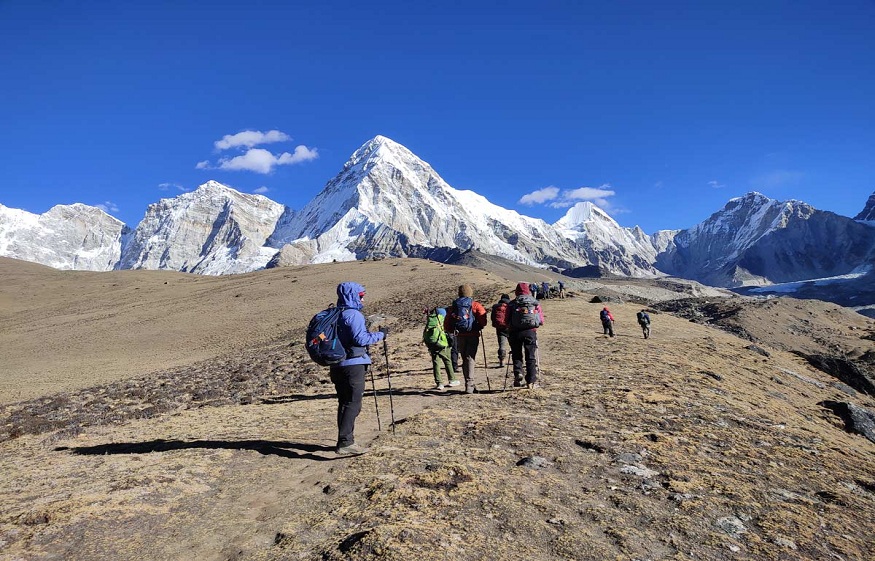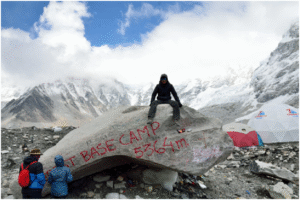How to Train for the Everest Base Camp Trek

The Everest Base Camps is one of the world’s great adventures, allowing trekkers to tread in the footsteps of mountaineers as they walk beneath the Himalayan gaze. Although it’s a non-technical hike — and so, you don’t need mountaineering experience — it does require a good deal of physical and mental preparation. The trek climbs to more than 5,000 meters, with long days of walking across varied (and often rugged) terrain. The secret to making each minute pleasurable is to start developing strength, endurance, and mindset long before you arrive in Nepal.
You should consider training for Everest Base Camp, ideally three to six months before your trek. Be sure to work on your cardiovascular fitness first, as you will be walking for hours a day, often uphill. The best training is hiking, particularly on trails that have an elevation gain. For those who live in a flat area, incline treadmill work or stair climbing can approximate the uphill terrain. You should aim to hike or power walk for 5–6 hours carrying a weighted backpack to mimic the conditions of your daily trek.
The core stability is also important North face is an inclined surface on which you move with each leg, so the leg strength will carry you, whether in climbing steep up and steep down. Add some strength training moves to your routine two to three times a week, such as lunges, squats, step-ups, and planks. This will prevent fatigue and the risk of injury. Don’t neglect upper body training, either, because your back and shoulders carry your daypack.
Ability to balance and flexibility, which many overlook but are essential on uneven trails. Including yoga or stretching sessions in your weekly plan will improve mobility, decrease muscle soreness, and promote recovery.
Altitude adaptation is just as paramount. You can’t simulate the high points at home, but you can train your body to handle stress through endurance work. If you live near higher elevations, utilize that terrain. Otherwise, think about a high-altitude mask or training system — but understand that these are not substitutes for real acclimatization, which has to be done progressively as you make the trek itself.
One other important aspect is mental preparation. Hiking to Everest Base Camp is physically rigorous in its own right, but it can also be mentally demanding, especially managing the altitude, cold nights, basic lodgings in remote regions, and long walks without any of the creature comforts. Aiming for mindfulness, positivism, and reasonable expectations will keep you focused and strong.
Before leaving, do a few long, full-day hikes with your actual equipment—boots, backpack, clothing, and all. This can be used to break in your footwear, acclimate to carrying weight, and modify anything that doesn’t feel quite right. Also, make sure to test your hydration and nutrition plan; staying fueled and hydrated is crucial at altitude.
Finally, talk to a doctor or travel clinic about altitude-sickness medications and ensure you’re healthy enough to go on high-altitude treks.
Everest Base Camp Trek Cost: Time and Effort Train for Speed and Use High Altitude | EverestLhojo Adventures is 7,500 feet of elevation gain. If you have the right physical conditioning and mental approach, you’ll not only make it to base camp—you’ll love every moment of the remarkable journey to get there.
Why You Need to Train for the EBC Trek
Everest Base Camp (EBC) trek training is not only a good idea, but you NEED to do this for your safety and enjoyment of the trek. Although the trek doesn’t require technical climbing, it does require great cardiovascular endurance, leg strength, and mental fortitude. The trek to base camp takes 12–14 days of hiking (5–7 hours daily), with continuous elevation changes and thinning air as you reach 5,364 meters (17,598 feet). Even seasoned hikers can struggle without adequate preparation.
Good training gets your body ready for long days of walking with a backpack, steep uphill sections, and the effects of high altitude. This also prevents injury and physical burnout. Most underestimate how challenging it is to trek up and down at altitude, with limited oxygen and energy for hours at a time, day after day. Focusing on a mix of cardio, strength, and endurance workouts, you’ll develop the stamina necessary for the journey.
Training also increases confidence. It’s an essential part of definitely feeling on a trip or a trek that your own body can manage the physical challenge of actually doing it and you can just think about the scenery (and ride it, although not think about the uphill climbs/what muscles to use where) and the culture (and go to it) and the experience (again, do it) instead of – you know, worrying about every uphill climb/fretting about sore muscles etc. A prepared trekker is a happy and successful trekker.
Trekking 101: Understanding Physical Demands of the Trek
Trekking to Everest Base Camp is a demanding trek that pushes you to your limits of stamina, strength, and willpower. It doesn’t require mountaineering or climbing skills, but the challenge comes from the length, altitude, and terrain. The journey is generally 130 kilometers (80 miles) round trip and takes 12 to 14 days. You’ll walk for 5 to 7 hours a day, sometimes along steep, rocky, or uneven paths.
The altitude is the hardest part. The trek starts in Lukla, at 2,860 meters, and goes all the way up to over 5,000 meters at Base Camp (plus an optional hike at 5,545 meters to Kala Patthar). The higher you go, the less oxygen there is in the air, making it more difficult to exert yourself physically. It can cause fatigue, shortness of breath, and, in some cases, altitude sickness.
And the temperature varies from warm sunny days to freezing nights, and accommodations are basic and have a few creature comforts. The combination can be physically and mentally draining, even for experienced trekkers.
You’ll train better if you understand these demands. This is not just about fitness — it’s about being fit, but fit combined with the mindset to be on the world’s most famous trekking trail, day after day, in all conditions.
Cardiovascular Training
Cardiovascular endurance is what you will be building first and foremost in your physical preparation for Everest Base Camp. You’ll be in the mountains for several hours each day, often at high elevation with limited oxygen, so your heart and lungs need to work efficiently to send fuel to your body. Cardio training and bouldering train your body to protect you from fatigue and flux: cardio improves your body’s way of transporting oxygen and helps you build your stamina and recover in between trekking days.
Trek to Base Camp Mount Everest Especially if you aren’t fit, begin with low-impact exercise such as walking, hiking, swimming or cycling. Your workouts will be longer and more intense at a slower rate. Each cardio session should be 45 to 90 minutes long, and aim for 3–5 sessions per week. Include interval training — switching between high and low levels of exertion — in your workouts to build endurance and mimic the varying topography of the trail.
Once your fitness has improved, move on to either hill training (better for being cardiovascularly efficient) or stair climbing (better mimicking the constant up-and-down of the trek). If you are fortunate enough to have mountains or trails nearby, start doing regular hikes with a weighted backpack to mimic actual trekking circumstances.
Good cardiovascular fitness diminishes fatigue, eases the acclimatization process, and lets you appreciate the scenery without feeling overly winded. With consistent cardio training, you will arrive in Nepal strong, energized, and ready for the adventure.
SHRED SQUATS: Strength and Endurance Workouts
Although cardio is the focus of many training plans, strength training and endurance work are just as vital for a successful trek to Everest Base Camp. Your legs, your core, and your back will be doing the heavy lifting — literally — so being strong muscularly will allow you to handle long days of hiking, particularly with a pack on difficult terrain.
Emphasize functional movements that reflect the hiking action. That should include exercises such as squats, lunges, step-ups, and deadlifts that activate your quads, hamstrings, glutes, and calves. Do these with added weight as you progress to simulate your trekking kit. A strong set of core muscles helps with posture and balance as well, so make some room for planks, Russian twists, and leg raises in your routine.
Strength train 2–3 times a week, along with endurance workouts that include longer sets or circuit training to simulate the sustained effort you’re going to need to trek. And don’t neglect your upper body, particularly your shoulders and back, to help carry your daypack without tiring or injuring yourself.
When paired with cardio, strength training improves overall endurance and mitigates your risk of injury, and will help you whether you’re putting the time into a steep ascent, merciless descent, or long day, and don’t want to feel wrecked at the end of each stage of your season.
S-Simple intensity: Hiking will approach a workout. Under the stress of loading, you will learn to carry and focus on moving through an intense workout.
Everest Base Camp Trek Hiking with a weighted backpack is an incredibly useful way to prepare for the Everest Base Camp trek. This feels more like the actual trekking experience than any gym workout can. When you’re on the actual trek, you’ll be carrying a daypack, which weighs 5–7 kg, containing water, snacks, extra clothing, and essentials. Training with this weight allows your body to adjust to the load while building the necessary muscles to carry it for hours.
Begin your training hikes on weekends or days off, and slowly raise the weight of your pack. Start with shorter hikes and work up to the 5–6 hour treks on trails with elevation gain, when you can. This develops your leg strength but, more importantly, your balance, coordination, and mental endurance.
Break in your equipment and boots using the same gear and shoes you will wear on your actual trek, so you don’t get blindsided. Your body will become accustomed to functioning with the pack, and you will find out what feels good or needs modifying.
Trekking with a loaded backpack also builds strength in your shoulders, back, and hips and develops cardiovascular endurance. It’s the closest thing to real-world trekking you’ll get, and it should be a staple in your Everest training regimen.
Elevation Training and Stair Climbing
Climbing stairs is one of the best and easiest ways to mimic the steep climbs and descents that you will be doing on the Everest Base Camp trek. If you lack access to natural slopes or hills, staircases and stair machines can simulate upwardly sloping ground while building leg strength, cardiovascular fitness, and endurance. Stair workouts also enhance balance and joint stability, in particular of the knees and ankles — two areas that take a beating over long treks.
Begin with lighter sessions and then slowly increase intensity. Attach a heavy pack as you would on the day of your actual trek. Mix slow but methodical climbs with quick bursts of faster feet to mimic variability in the trails. Get 30–60 minutes of stair work 2–3 days a week.
If you can, add in some real elevation training — hiking at altitude — to let your body start to acclimatize to thinner air. While that’s not an option for everyone, even a few visits to higher elevations can help.
Stair and elevation training says nothing about the intense form of mental toughness Everest will require from you, but it’ll help prepare you for those relentless slopes. She calls these workouts, if done regularly, the ones that would give your legs the stamina and the power to take the Himalayas one step at a time.
Flexibility and Mobility Workouts
Everest Base Camp Treks Flexibility and mobility exercises are commonly neglected when preparing for treks, however, they are critical to keeping your body limber and reducing potential injuries while trekking to Everest Base Camp, as well as improving recovery times. All those hours of walking can tighten the muscles in the hips, calves, hamstrings, and lower back. Stretching and mobility work regularly prevent stiffness and fatigue.
Keep dynamic stretches for before workouts and static stretches for after training sessions or hikes. Focus: Contains hip flexors, IT bands, quads, glutes, calves, and lower back. And basic, low-intensity motion, like lunges, hip openers, hamstring stretches, and spinal twists, can dramatically help mobility.
Incorporating yoga or Pilates into your routine once or twice a week can go a long way toward improving your balance, flexibility, core strength, and mental focus — all things that will help you out on the trail. These practices also cultivate body awareness, allowing you to notice imbalances or tension before they become problems.
You will be thankful for staying mobile and supple as your training progresses. Flexibility isn’t only instrumental in ensuring you can make the movements necessary to keep trekking — it can help prevent injury, allow for faster recovery, and make the overall experience more pleasant.
Make sure you are prepared in your mind.
The Everest Base Camp trek challenges you physically because it’s a mental test in rugged scenery, unpredictable weather, and at high altitude. Just as physical training is a key component, so too is mental preparation. You’ll slog through long days on the trail, intermittent soreness, and periods of fatigue or anxiety. A lot of your success and enjoyment of the process will depend on your ability to remain positive, patient , and resilient.
Set realistic expectations from the get-go. You’re not going to be racing toward the base camp — it’s surviving, not speeding. Permitting oneself to manage anxiety around the slow pace of altitude trekking also helps avoid burnout. Try to remain in the moment, especially during tough workouts. Building a mental “toolbox” with strategies including mindfulness, deep breathing, and visualization can help you power through difficult days.
Mount Everest Base Camp Trek Learn to be comfortable with discomfort. Adjusting to fewer showers, cold mornings, basic lodgings — all discomfort can be embraced, a part of the adventure, building mental toughness.
Maintaining a good attitude, remaining flexible with plans, and celebrating small wins on the trail, such as hitting a new elevation or finishing a long hike, will take you far. Your mentality might get you to Everest Base Camp as much as your fitness.
Acclimatization and Breathing Techniques
One of the hardest aspects of the Everest Base Camp trek is dealing with altitude. As you ascend, the air becomes thinner and your body gets less oxygen, which can cause symptoms of altitude sickness. True acclimatization occurs only during the trek, but you can at least start preparing your body and lungs beforehand with specific breathing techniques and fitness strategies.
Deep diaphragmatic breathing, yoga breathing (including pranayama), and box breathing all help decrease the body’s need for breath by enabling the lungs to use oxygen more efficiently and improving oxygen delivery to your muscles. These exercises also strengthen breath control, decrease anxiety, and allow you to remain calm and focused while climbing at high elevations.
(“Sleep high, climb low” acclimatization is applied throughout the trek; trekkers climb in altitude to sleep low, and spend rest days at important elevations. Your training should also mimic extended low-oxygen work, which is why long-duration cardio, hill training, and even altitude-simulating masks (which are optional) can help.
Moreover, proceeding gradually, drinking enough water, and eating well along the way all play an important role in healthy acclimatization. “The better your lungs and cardiovascular system are trained to deal with strain, the easier it will be for you to acclimatize when you’re trekking above 3,000 meters.”
Training: A Schedule Before The Trek
A well-rounded training plan for Everest base camp should start at least 12–16 weeks before your trip, depending on your journey. That allows your body to make gradual adaptations, so the risk of injury is minimized and sustainable endurance is built.
Everest Base Camp Months 1–2 (Foundation Phase): Focus on moves that increase your overall cardiovascular fitness — brisk walking, cycling, swimming, or hiking three to four times a week. Begin strength training 2–3 times a week on your lower body, core, and upper body. Take the time to do one or two flexibility sessions, and get acquainted with your gear.
Month 3 (Elevation Simulation & Backpack Training): Start stair climbing and weighted hikes. Pump up the length and intensity of your cardio sessions. Get sharp at hiking in the gear you’ll be using on the trek, especially boots and a pack loaded with the weight you’ll carry over the day.
Month 4 (Taper & Trek Simulation): Cardio and strength are still on the schedule, but ease the intensity a little for recovery. Emphasize long weekend hikes, preferably 5–6 hours on the trail with the pack. Concentrate on mental, breath, and mobility components.
During the course of this timeline, try to take 1–2 rest days per week and log your progress. During the final two weeks before you depart, concentrate on staying healthy, getting good sleep, and keeping your mind on task. With regular training, you can confidently tackle one of the most amazing journeys out there, trek to Everest Base Camp.
How Do You Train for Everest Base Camp?
Training for the Everest Base Camp (EBC) trek is vital to ensure you are physically prepared for the upcoming challenges. The trek brings hikers above 5,000 meters (17,598 feet) and demands endurance, strength, and mental resilience. Although you don’t need technical climbing skills, the physical demands are still considerable, with long days of walking, steep ascents, and varying weather conditions.
Focus on Cardio First. This is important when you are hiking long and hard. Try for 3–5 cardio workouts a week, like brisk walking, cycling, swimming, or running. Build the intensity and duration gradually to build the endurance required for hiking 5–7 hours a day with a large pack. Incorporate interval training to build your endurance on long, steep hills and various terrain.
Strength training is also important. Incorporate lower body moves with squats, lunges, and step-ups for leg strength, and strengthen your core through planks and leg raises for stability. Shoulders: Perform weight exercises to help you carry your daypack comfortably.
For the trek, train with a weighted backpack. Get started with a lighter pack and gradually add weight as you develop strength. That will help you adjust to the extra weight you’ll bear during the hike. Hike hilly terrain, if possible, or use stairs to simulate the trek’s up and down nature.
Also, you should work on your flexibility and mobility to prevent injury and reduce muscle fatigue. Add regular stretching or yoga to your routine.
Himalayan Base Camp Trek Finally, prepare yourself mentally by setting realistic expectations for the trek. Be positive, learn to lean into the discomfort, and be patient. Just as physical training prepares you for obstacles along the way, mental preparation is key to ensuring you are up to the challenge.
How Much Training Do You Need to Get to Everest Base Camp?
- How much training do you need to do to get to Everest Base Camp (EBC)? But no matter where you begin, a solid training plan is key to success.
- From 3 to 6 months of preparation for a budding professional. That gives you plenty of time to develop your cardiovascular fitness, strength, and mental resilience. The aim is to hike with a 5–7 kg (11–15 lbs) pack for 5–7 hours a day without feeling burned out. Begin simply, doing basic cardio exercises like walking, biking, or swimming, and gradually build up intensity and duration. Hiking on hilly terrain or stair climbing is best to mimic the incline and elevation you are likely to encounter on the trek.
- Strength training: legs and core. Things like squats, lunges, and step-ups will help to build leg strength; planks, deadlifts, and other core exercises will help with stabilization and endurance. Goal for 2–3 lifts a week.
- If you’re already in shape and have experience in hiking, you’ll want to focus on elevation training, hill hikes, and getting practice with the pack. Progress your pack weight and workout intensity gradually. It’s tough to acclimate your body to the harsh conditions of high altitude before your trek, but training with high-altitude masks or taking short trips to higher elevations can help recreate the experience.
In the end, the more time you can invest in training, the more pleasurable and successful your trek will be.
How to Plan the Everest Base Camp Trek?
You’ll need to think carefully about your plans for the Everest Base Camp trek so that you can prepare yourself for the physical, logistical, and environmental challenges. Here’s a step-by-step approach to help you plan your adventure:
- Study the Trek: Get an idea about the terrain, daily hiking duration, altitude, weather, and stay. Know the start point of the Everest Base Camp route, which usually starts in Lukla and goes through the famous spots of Namche Bazaar, Tengboche, and Dingboche.
- Trek in the Right Season: The ideal seasons to hike are spring (March-May) and autumn (September-November). The weather is most stable with clear skies and moderate temperatures.
- Get Your Permits: You will need to have an Everest National Park entry permit and a TIMS card (Trekking Information Management System). You can also get these in Kathmandu or Lukla.
- Book Flight and Accommodation: The normal process of starting the trek is flight reservations from Kathmandu to Lukla. Avoid peak seasons, and plan your flight in advance, as they get booked quite quickly! It includes all necessary permits and accommodation in Kathmandu, Lukla, and along the trail.
- Packing: Make sure you bring the right clothing and equipment — good boots, warm layers, a waterproof shell, and a good sleeping bag. Take your first aid kit, sunscreen , and water cleansing pills.
- Arrange Guides and Porters — Although you can trek independently, hiring a guide and a porter will greatly enhance your experience. They’ll help you with navigation, help you acclimate properly, and help carry your gear.
- Health & Fitness: For training, gear is needed to prepare yourself physically. It’s also smart to consult a doctor before the hike to discuss altitude sickness prevention and any shots that might be needed.
- Itinerary: Plan your route, including trekking days and rest days for acclimatization. (Typically, a trek takes at least 12–14 days, with plenty of rest days in places such as Namche Bazaar and Dingboche for proper acclimatization.)
The good news is that with a little planning, your trek to Everest Base Camp can be safe, memorable, and enjoyable.
How Fit Do I Need to Be for the Everest Base Camp Trek?
The Everest Base Camp trek is challenging, but not a mountaineering expedition. Its need for athleticism, endurance, power, and cardio health is a very high one. You do not need to be an elite-level athlete, but being reasonably fit will make this experience so much nicer.
Your cardiovascular endurance should be the main focus, as you’ll be trekking 5–7 hours a day at changing altitudes. Get fit to ride through brisk walks, cycling, or running. Try to do 3–5 cardio sessions per week, working your way up in intensity and duration.
Strength training is also a staple because the long hikes, especially ones you’ll be doing, are uphill with a weighted backpack. Best to focus on lower body strength (squats, lunges, step-ups) and core stability (planks, deadlifts). These drills will allow you to take on steep climbs and rough terrain with greater ease and less fatigue.
Acclimatization to altitude occurs gradually through the course of the trek, but it’s beneficial to build your cardiovascular fitness beforehand so your body can better adapt to the thinner air. Grit is useful as well, since high-altitude trekking is tough mentally, too. Unplug your mind from the future, and you may find that slow, steady progress is what will take you where you need to go, eventually.
In summary, you don’t have to be a seasoned hiker or extreme athlete, but good physical prep work is essential for completion and enjoyment of the EBC trek.






